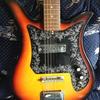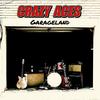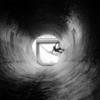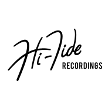stratdancer

Joined: Dec 11, 2013
Posts: 2537
Akron, Ohio



|

Posted on Dec 04 2016 05:08 AM
In an effort to get the absolute best tone the age old question of buffered and true bypass pedals always comes up. Long cable runs and using multiple effects pedals can rob tone and it is recommended that using at least one buffered pedal will condition the signal to counteract the resistance of long cable run through the pedals.
My question is if you have one or two "always on" pedals such as the EP Boost then that should be enough to condition the signal path to the amp. I have one pedal on my board that can be set to buffer or true bypass. Currently it is in buffer but maybe it doesn't have to be considering I use two "always on" boost pedals. Maybe the buffered pedal should be set to true bypass.
Any "techy" tone geeks have an opinion?
— The Kahuna Kings
https://www.facebook.com/pages/The-Kahuna-Kings/459752090818447
https://thekahunakings.bandcamp.com/releases
Last edited: Dec 04, 2016 05:09:47
|
Ariel

Joined: Aug 29, 2009
Posts: 1556
Israel






|

Posted on Dec 04 2016 06:29 AM
stratdancer wrote:
if you have one or two "always on" pedals such as the EP Boost then that should be enough to condition the signal path to the amp.
That is generally correct. Buffers are usually implemented effectively in front OR last in the chain.
Don't you also use a Reverb that's always on? That's a buffered signal right there.
Because each rig is individual, still you should try all your options and decide with your ears.
Loss of treble is not always a bad thing, but it can affect your playing dynamics.
All buffers are not the same, the 'compensation' can be too much.
I found out that a CLEAN signal fed into my Surfy-Bear comes out harsher with less dynamic range if buffered (when no FX applied).
Last edited: Dec 04, 2016 06:34:00
|
Teiscofan

Joined: Feb 21, 2011
Posts: 513
Ontario


|

Posted on Dec 04 2016 07:27 AM
A fortuitous post as last night I was reseraching the same thing! I found this article helpfull.
http://guitargearfinder.com/guides/true-bypass-buffers-guitar-pedals/
— I am not obsolete, I am RETRO.... 
Last edited: Dec 04, 2016 07:28:43
|
Las_Barracudas

Joined: Apr 24, 2011
Posts: 1087
Surf City, NC





|

Posted on Dec 04 2016 07:53 AM
Well, personally I like True Bypass pedals in my chain and try to keep the signal path as short as possible.
In my experience multiple Buffered pedals can color your over-all tone in a bad way.
Cheap cords and patch cables can also substantially degrade your tone, therefore I'm always trying to keep it simple with as few patch cables as possible and try to keep my cords as short as practical.
I can't tell you how many times I've removed pedals from my board in order to achieve a better signal path.
— METEOR IV on reverbnation
|
Fady

Joined: Mar 07, 2010
Posts: 2274
North Carolina









|

Posted on Dec 04 2016 09:35 AM
+1 in the "No one right nor wrong answer" camp.
Unlike Audiophile hi-fi stuff where the game seems to be universal pursuit of the absolute least compromise to the signal, what our ears like about amplified/electric guitar, what sounds musically interesting and appealing is actually a compromised signal.
The trick in all of this is figuring out what the right mix of compromise is for your sound and your setup.
This is particularly important to pay attention to in Surf because those top end treble frequencies that most of these conversations are focused on are where the infectious 'drip' lives too. And, and, it is a fine line between sweet and musical and too thin, shrill, or sterile.
All the best in your tone quest! \m/ \m/
— Fady
El Mirage @ ReverbNation
|
stratdancer

Joined: Dec 11, 2013
Posts: 2537
Akron, Ohio



|

Posted on Dec 04 2016 05:40 PM
Thanks for all the replies. I guess it comes down to trial and error and see what sounds best.
— The Kahuna Kings
https://www.facebook.com/pages/The-Kahuna-Kings/459752090818447
https://thekahunakings.bandcamp.com/releases
|
psychonaut

Joined: Dec 08, 2007
Posts: 1305


|

Posted on Dec 04 2016 06:11 PM
|
CrazyAces

Joined: Jul 31, 2012
Posts: 4054
Buffalo, N.Y.





|

Posted on Dec 04 2016 06:44 PM
stratdancer wrote:
Thanks for all the replies. I guess it comes down to trial and error and see what sounds best.
It's good to know the science but I think it's important not to let the science dictate. Your ears know what's best for you and sometimes the combinations are surprising.
Cheers,
Jeff
— http://www.facebook.com/CrazyAcesMusic
http://www.youtube.com/user/crazyacesrock
http://www.reverbnation.com/crazyacesmusic
|
JakeDobner

Joined: Feb 26, 2006
Posts: 12159
Seattle



|

Posted on Dec 04 2016 07:51 PM
This is not a spec I look at in a pedal, it just isn't important. I'd take compromised tone if it meant having a pedal that I felt took me further "there".
|
stratdancer

Joined: Dec 11, 2013
Posts: 2537
Akron, Ohio



|

Posted on Dec 05 2016 05:51 AM
I go from guitar into an EP Boost that is always on then into a Soul Food that I rarely use in surf but it is set to buffer. Then it goes through the rest of the pedal board. It is all true bypass including another slight boost. I will just have to check the tone if I pull the Soul Food and see what it does.
— The Kahuna Kings
https://www.facebook.com/pages/The-Kahuna-Kings/459752090818447
https://thekahunakings.bandcamp.com/releases
|
choice_of_meat

Joined: Oct 04, 2013
Posts: 42
|

Posted on Dec 08 2016 04:25 PM
Beyond the Buffer... as the article posts above states the impedance is a key also to think about.
Many pedals have impedances that are made for specific passive guitar pickup loading (like some fuzzes) ZVEX SHO, etc...
Stacking 2 such pedals would basically be against the design intent of many of these pedals; and of course can be abused for effect.
Your EP pedal has a Input Impedance: of 1M ohm and an Output Impedance: 1k ohm If you run that into the Soul Food which has an input impedance of 1MOhm. The output impedance ranges from 650Ohm to 3.3kOhm. You prob run into impedance mismatch or whatnot, which as an effect on the sound, and this understanding as the articles etc.. point out above at least give you an educated place to start your tone quest.
Boy I never try to explain this stuff on forums.. back to music!
Last edited: Dec 08, 2016 16:28:16
|
Tqi

Joined: Dec 07, 2014
Posts: 1222

|

Posted on Dec 08 2016 10:21 PM
-
Last edited: Feb 02, 2024 12:14:51
|
da-ron

Joined: Jan 02, 2009
Posts: 1307
The original Plymouth, UK.






|

Posted on Dec 09 2016 08:04 AM
A long cable acts as a capacitor and will affect your tone. So a buffer compensates for this. Whether it does it well or not though?
When we use any length of cable it'll act as a capacitor and affect our tone, so we adjust the controls until we get the tone we like. The same thing would happen if you used a lot of pedals or a lot of cable - you'd adjust it til it sounded OK.
A/B tests are all very well and good at showing the effect in action, but whatever you have, you adjust it til it sounds OK. Then yours and everyone's ears gets used to it and no-one really notices any more.
— http://thewaterboarders.bandcamp.com/
|
Tqi

Joined: Dec 07, 2014
Posts: 1222

|

Posted on Dec 09 2016 08:07 AM
-
Last edited: Feb 02, 2024 12:15:00
|
da-ron

Joined: Jan 02, 2009
Posts: 1307
The original Plymouth, UK.






|

Posted on Dec 09 2016 08:08 AM
A resistor on it's own doesn't affect tone, but add it to a capacitor and you have a basic filter circuit.
— http://thewaterboarders.bandcamp.com/
|
Tqi

Joined: Dec 07, 2014
Posts: 1222

|

Posted on Dec 09 2016 08:19 AM
-
Last edited: Feb 02, 2024 12:20:02
|
stevel

Joined: Oct 12, 2012
Posts: 219
Hampton Roads, Virginia

|

Posted on Dec 10 2016 04:14 PM
IME, it really depends on if you set up your rig "at full cable length" or not.
If you have a pedal, and 20 feet of cable on either side, you're getting a 40 foot cable.
All of the videos point this out and make it sound really noticeable by plugging a 5 foot cable into the amp/buffer and a 70 foot cable on the backside.
Ok. Who really does that?
If you set it up with a 40 footer to begin with, then all true bypass pedals are not going to change the tone. Likewise, if you consider all the patch cable length when you set it all up, and set up the "straight" signal to your liking, then all true bypass pedals will not change anything when bypassed.
Remember ye olden dayes when people played with coiled cables - how long were they?
Basically, a buffer negates all the cable after it. But virtually all of them change the tone of the signal when bypassed so it's still not really your 20 footer with anything after taken out of the equation.
For me, the difference between 20 and 40 feet could easily be made up with a turn of the treble control so it never really bothered me.
|
choice_of_meat

Joined: Oct 04, 2013
Posts: 42
|

Posted on Dec 15 2016 12:01 PM
So you can really go down the rabbit hole on this whole topic, it seems. I'm still trying to wrap my head around how the capacitance of a cable interacts with the impedance loading of buffers like the SHO, fuzzes, & tube preamps.
A good approach people seem to take is to have a tube buffer in place as early as possible in your chain, preferably first. Analogman, Sarno, etc.. all take this approach.
which leads to the fact that AFAIK, a tube fender tank is that if you plug straight in. beyond the drip.. another good reason for a tube tank! :->
|
Tqi

Joined: Dec 07, 2014
Posts: 1222

|

Posted on Dec 15 2016 06:40 PM
-
Last edited: Feb 02, 2024 12:23:28
|







































